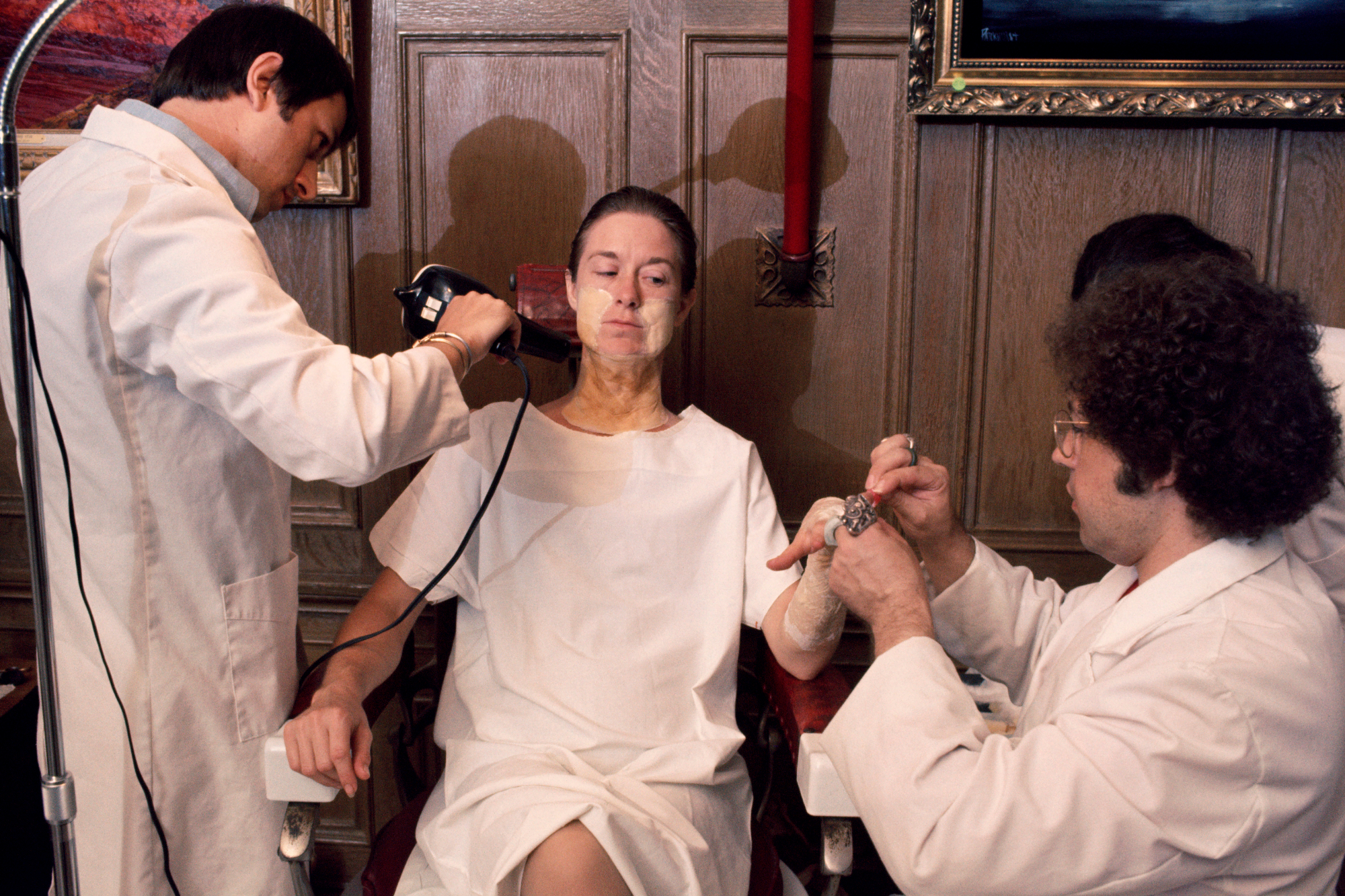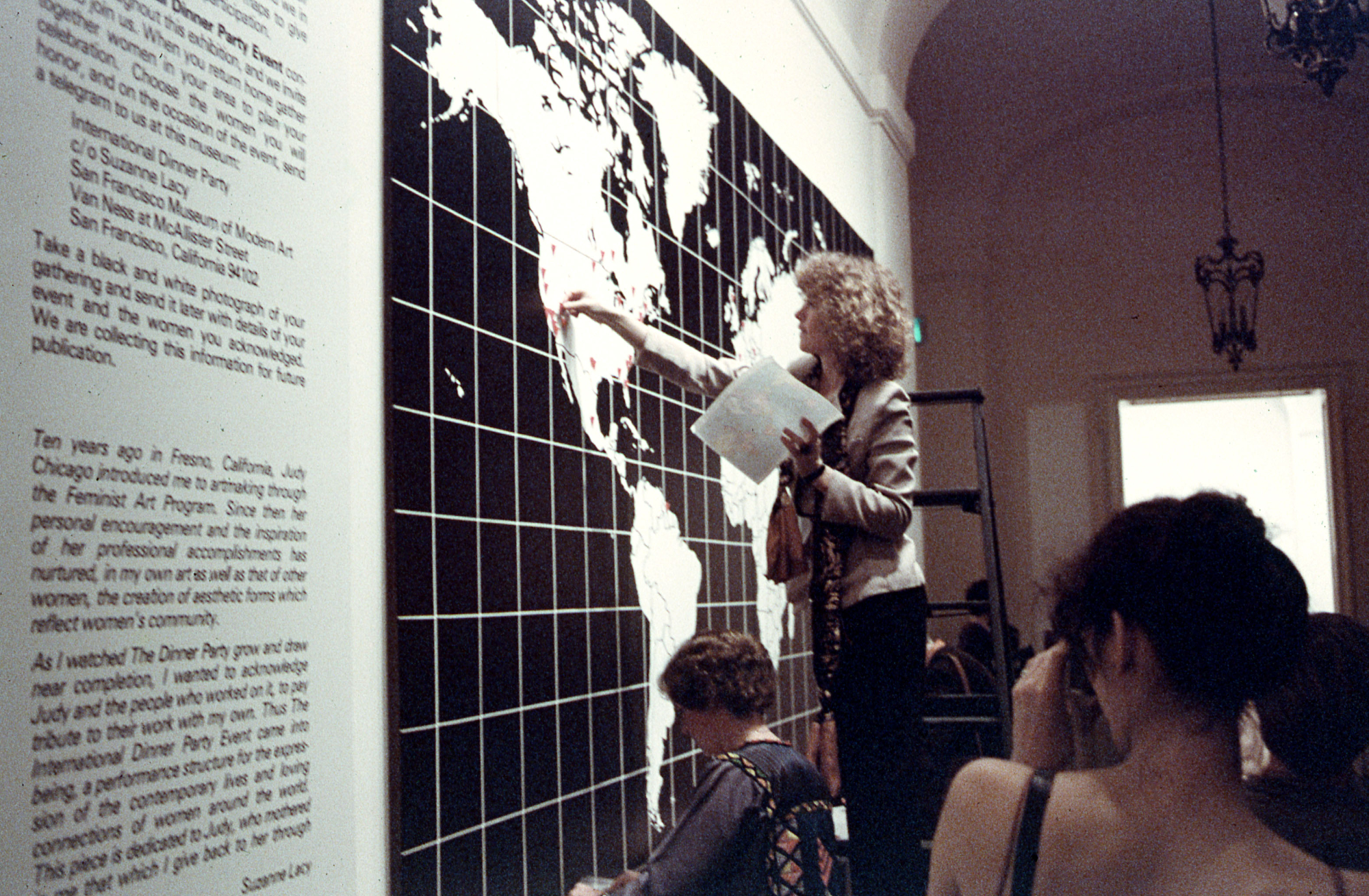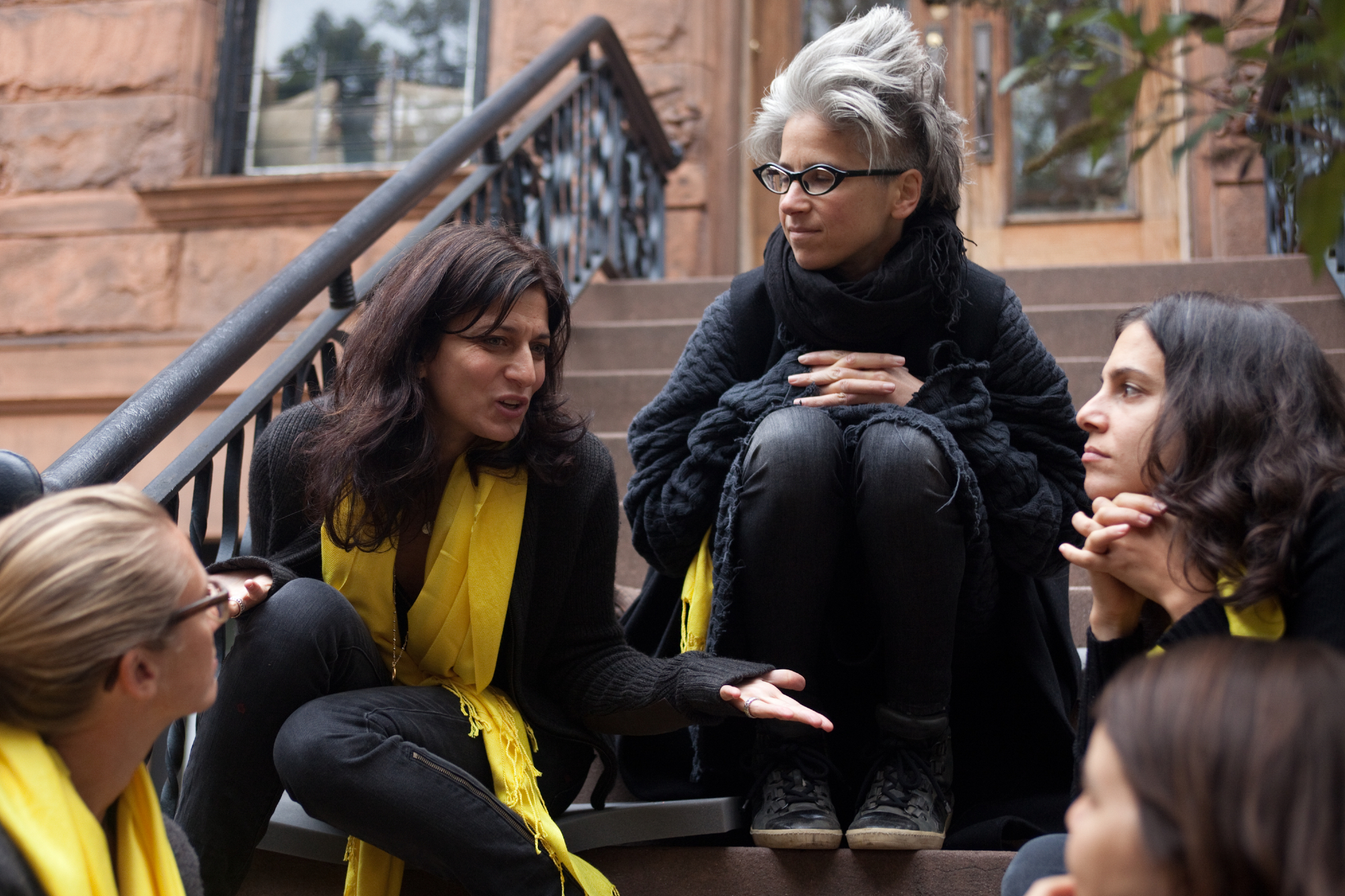スザンヌ・レイシー
Suzanne Lacy

避けられない連合
1976年
デジタルプリント、新聞記事、広告、手紙、ノート、フォト・コラージュ、写真資料
サイズ可変
作家蔵
制作協力:株式会社 学士会館精養軒、一般社団法人 学士会
Inevitable Associations
1976
Digital print, article, advertisement, letter, notebook, photo collage, and photograph
Dimensions variable
Collection of the artist
Production support: Gakushikaikan Seiyouken Co., Ltd.; University Alumni Association GAKUSHIKAI
避けられない連合
1976年
デジタルプリント、新聞記事、広告、手紙、ノート、フォト・コラージュ、写真資料
サイズ可変
作家蔵
制作協力:株式会社 学士会館精養軒、一般社団法人 学士会
本作は、レイシーが当時改装中だったビルトモア・ホテル(ロサンゼルス)で女性の老化をテーマに行った2日間のパフォーマンスで、ホテルの改装に関する新聞記事がきっかけとなったものです。記事は、「顔のフェイスリフトをするビルトモア」という見出しで、ホテルを女性に例え、若さを女性の美徳とするものでした。
パフォーマンスの初日、レイシーはホテルのロビーにブースを3つ設けました。最初のブースでは若い女性が、ホテルを老いた未亡人に例えた新聞記事とホテル従業員のインタビュー記事を配りました。次のブースでは整形外科医助手が整形手術のビフォー・アフターを説明し、最後のブースではハリウッドのメイクアップ・アーティストがレイシー自身を特殊メイクで老女にしました。最後のブースの向かい側には赤い椅子が並べられ、老齢の女性10人が徐々に集まり着席していきました。メイクを終えたレイシーは、老女たちによって、彼女たちと同じような黒い衣装を着せられ、一緒に赤い椅子の前に集合しポーズをとった後、会場の群衆のなかに消えていきました。2日目には、初日に参加した老女を観客が囲む3つのグループが作られ、「歳を取るというのはどういうことか」をレイシーが解説した後、「60歳を過ぎてからの人生」について、老女たちに話を聞きました。この作品は、老化における性差別に光を当て、年老いて軽視される女性たちに関わり問題提起を続けるレイシーの姿勢を表しています。
Inevitable Associations
1976
Digital print, article, advertisement, letter, notebook, photo collage, and photograph
Dimensions variable
Collection of the artist
Production support: Gakushikaikan Seiyouken Co., Ltd.; University Alumni Association GAKUSHIKAI
Inevitable Associations was a two-day performance by Lacy on the theme of aging women at the Biltmore Hotel in Los Angeles, which had been under renovation at the time, and was inspired by a newspaper article about its refurbishment. The article was headlined, “Biltmore has face-lift,” thereby comparing the hotel to a woman and making youthfulness out to be a female virtue.
On the first day of the performance, Lacy set up three booths in the hotel lobby. At the first booth, a young woman handed out newspaper articles comparing the hotel to an old widow and interviews with hotel employees. At the second booth, an assistant to a plastic surgeon explained the before and after of plastic surgery. In the last booth, a Hollywood makeup artist was applying special makeup to Lacy to make her look like an old lady. Red chairs were lined up opposite to the last booth, and ten old women gradually gathered and sat on chairs. After finishing her make-up, old women dressed Lacy in black alike to them. They all lined up together in front of the red chairs and posed before dispersing in the crowd. On the second day, three groups each with an old woman who had participated on the first day surrounded by audience were made, to listen to Lacy's interpretation of againg, followed by stories from each old lady how life was like after the age of sixty. This work sheds light on sexism in relation to aging, and represents Lacy’s commitment to older women who find themselves neglected and overlooked.

インターナショナル・ディナー・パーティー
1979年
地図(デジタルプリント)、指示書、電報、手紙、封筒、ポストカード、ファイル、フォト・コラージュ、写真資料
サイズ可変
作家蔵
International Dinner Party
1979
Map (digital print), instruction, telegram, letter, envelope, postcard, binder, photo collage, and photograph
Dimensions variable
Collection of the artist
スザンヌ・レイシー(リンダ・プロイスとの共作)
インターナショナル・ディナー・パーティー
1979年
地図(デジタルプリント)、指示書、電報、手紙、封筒、ポストカード、ファイル、フォト・コラージュ、写真資料
サイズ可変
作家蔵
《インターナショナル・ディナー・パーティー》は1979年3月14日に全世界で開催された夕食会のパフォーマンスです。レイシーの師であるジュディ・シカゴ(1939年-)が同日にサンフランシスコ近代美術館で初めて発表した、代表作《ディナー・パーティー》(1979年)へのオマージュとして実施されました。
時差のために24時間にわたって開催された本プロジェクトは、世界各地の女性の功績を称えるもので、キューバ出身のアナ・メンディエタ(1948-1985年)やアメリカ人アーティストのキャロリー・シュニーマン(1939-2019年)など、フェミニストアートのパイオニアも参加しました。
最終的には2000人以上が参加し、サンフランシスコ近代美物館には参加した200以上のグループから電報が届きました。レイシーとプロイスはそれらを地域ごとのバインダーに入れ、美術館の壁に貼られた世界地図上にディナー開催地の印をつけていきました。この作品は、インターネット以前のフェミニストの相互の繋がり、世界的な広がりを示すという意味でも重要な作品だといえます。
Suzanne Lacy with Linda Preuss
International Dinner Party
1979
Map (digital print), instruction, telegram, letter, envelope, postcard, binder, photo collage, and photograph
Dimensions variable
Collection of the artist
International Dinner Party is a worldwide dinner party that was held in the evening of March 14, 1979. This is a happening that was contributed to the first presentation of The Dinner Party (1979), a masterpiece by Lacy’s mentor, Judy Chicago (1939-) at the San Francisco Museum of Modern Art on the same day.
Held over a 24-hour period due to the time differences, the event honored the achievements of women from around the world and included feminist art pioneers such as the Cuban-born Ana Mendieta (1948-1985) and American artist Carolee Schneemann (1939-2019).
In the end, more than 2,000 people participated, and the San Francisco Museum of Modern Art received telegrams from over 200 participated groups around the world. Lacy and Preuss put them in binders organized by region and marked the locations of the participants on a world map on the wall of the museum. This work is important for how it showed the interconnectedness and global reach of feminists before the advent of the internet.

玄関と通りのあいだ
2013/2021年
3チャンネル・ビデオ、デジタルプリント
ビデオ:20分2秒
作家蔵
Between the Door and the Street
2013/2021
3-channel video and digital print
Video: 20 min. 2 sec.
Collection of the artist
玄関と通りのあいだ
2013/2021年
3チャンネル・ビデオ、デジタルプリント
ビデオ:20分2秒
作家蔵
本作はクリエイティブ・タイム(ニューヨーク)、ブルックリン美術館エリザベス・A・サックラー・センター・フォー・フェミニスト・アートの協賛によって2013年に制作されました。
《玄関と通りのあいだ》は、2013年10月19日、365人の活動家がブルックリンの住宅街の一角に集まって行われた壮大なスケールのパフォーマンスです。パフォーマンスでは、黄色いストールを身に着けた参加者が60のグループに分かれ、玄関と通りのあいだの階段に座り、人種、民族的アイデンティティ、階級、フェミニズムなど様々な問題について話し合いました。およそ2500人の聴衆が通りを歩きながら彼女たちの会話を聞いていました。レイシーは同時に、ブルックリン美術館入口の大階段を使用して、コミュニティ全体にフェミニズムに関する問いを投げかけるインスタレーションも展開しました。本展では、パフォーマンスの記録映像を三面プロジェクションで展示するほか、会場の床とベンチにメッセージのインスタレーションを再現しています。
このプロジェクトは、ニューヨーク市在住の女性活動家とレイシーの5か月にわたる様々な話し合いから生まれました。玄関と通りのあいだの空間での対話を通じて、性別、人種、民族、階級など、幅広いフェミニズムに関する議論の重要性を個々人が実感したのです。
Between the Door and the Street
2013/2021
3-channel video and digital print
Video: 20 min. 2 sec.
Collection of the artist
This project was initially implemented with sponsorship by Creative Time, New York, and the Elizabeth A. Sackler Center for Feminist Art, Brooklyn Museum.
Between the Door and the Street is a performance of epic proportions that took place on October 19, 2013, when 365 activists gathered in a corner of a residential neighborhood in Brooklyn. During the performance, participants wearing yellow scarves and divided into sixty groups sat on the steps between the front entrance and the street and discussed various issues such as race, ethnic identity, class, and feminism. An audience of about 2,500 people listened to their conversations as they walked down the street. At the same time, Lacy also created an installation using the grand staircase at the entrance of the Brooklyn Museum that posed questions related to feminism to the entire community. This exhibition presents a three-sided projection of the video recording of the performance, together with the installation of messages on the gallery's floor and the benches.
This project was the culmination of five months of various discussions between Lacy and activists in New York City. Through dialogues that unfolded at the porches, each individual realized the importance of discussing a wide range of issues related to feminism, including gender, race, ethnicity, and class.
アーティスト一覧ARTISTS
- Etel Adnan|エテル・アドナン
- Phyllida Barlow|フィリダ・バーロウ
- Anna Boghiguian|アンナ・ボギギアン
- Miriam Cahn|ミリアム・カーン
- Lili Dujourie|リリ・デュジュリー
- Anna Bella Geiger|アンナ・ベラ・ガイゲル
- Beatriz González|ベアトリス・ゴンザレス
- Carmen Herrera|カルメン・ヘレラ
- Kim Soun-Gui|キム・スンギ
- Suzanne Lacy|スザンヌ・レイシー
- Mishima Kimiyo|三島喜美代
- Miyamoto Kazuko|宮本和子
- Senga Nengudi|センガ・ネングディ
- Nunung WS|ヌヌンWS
- Arpita Singh|アルピタ・シン
- Robin White|ロビン・ホワイト

